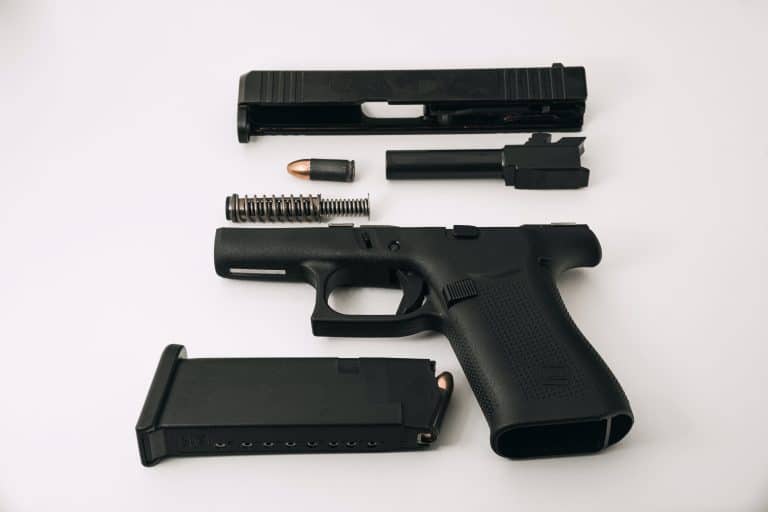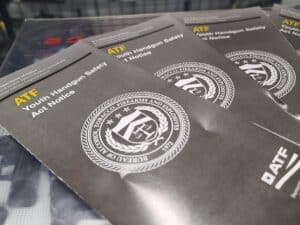An internal Department of Justice document explaining how the Biden Administration plans to restrict so-called ghost guns was leaked on Tuesday.
The 107-page document, obtained by The Reload, outlines changes the Bureau of Alcohol, Tobacco, Firearms, and Explosives (ATF) wants to make to outlaw the sale of homemade gun kits by unlicensed manufactures. At the direction of President Joe Biden, the agency plans to propose federal rule changes, which would require anyone selling unfinished firearms receivers to obtain a federal license and mark the parts with a serial number. Anyone who continues to sell unfinished receivers without a license could face federal felony charges.
April Langwell, chief of the ATF’s Public Affairs Division, neither confirmed nor denied the document’s authenticity. She told The Reload she could not “comment on internal communications or deliberations on potential or hypothetical rulemakings.”
The document reworks and broadens the definition of what parts constitute a regulated firearm receiver. It then says any unfinished part that “may readily be converted” into a receiver must be treated as a receiver and requires sellers to obtain federal licenses, mark the unfinished parts with serial numbers, and perform background checks on buyers. The proposal provides only subjective standards for what makes an unfinished part “readily” convertible into a finished firearm but provides footnotes to court cases where the term has been applied. One court example included in the document said a part completed in “around an eight-hour working day in a properly equipped machine shop” was considered “readily” convertible. The only example of a ruling defining when a part is not “readily” convertible involved a process that “required [a] master gunsmith in a gun shop and $65,000 worth of equipment and tools.”
The examples provided in the document show the proposed rule would likely outlaw the sale of any unfinished receiver, especially when included in a kit with other parts and instructions or tools needed to complete the part. That’s because most unfinished parts sold in America today, including so-called 80% AR-15 lowers, can be finished at home in a few hours with commonly available tools like drill presses and compact mills.
The ATF said in the proposal it expects the rule will have a “significant impact” on companies currently selling unfinished receivers, but it expects them to adapt to the new rule.
“Based on current marketing related to the unregulated sale of certain firearm parts kits, ATF anticipates that these non-FFLs would either become FFLs or would take a loss in revenue to sell a parts kit that does not contain a frame or receiver, or simply sell the frame or receiver, but not both,” the document said.
The full proposal won’t be made public for another two weeks, and details could change between now and then. However, the draft is in line with comments made by President Biden when he directed the DOJ to make new rules outlawing the sale of so-called ghost gun kits on April 8.
“I want to see these kits treated as firearms under the Gun Control Act, which is going to require that the seller and manufacturers make the key parts with serial numbers and run background checks on the buyers when they walk in to buy that package,” Biden said in a speech at the White House.
The document also lays out plans to broaden and update the federal definition of firearms receiver to correct a problem with the ATF’s interpretation of the current definition. Courts have begun questioning the ATF’s long-running determination that an AR-15 lower is a receiver despite not including several of the parts required in the current definition. Prosecutors have been forced to drop cases involving the ATF’s determination in recent years.
The ATF admitted in the document that “neither the upper nor the lower portion of a split/multi-piece receiver firearm alone falls within the precise wording of the regulatory definition” but lashed out in the document at the “erroneous district court decisions” that employ a “narrow interpretation” of the definition.
“These courts’ interpretation of ATF’s regulations, if broadly followed, could mean that as many as 90 percent of all firearms now in the United States would not have an identifiable frame or receiver,” the document said. “Those firearms would include numerous widely available models, such as Glock-type and Sig Sauer P32013 pistols, that do not utilize a hammer – a named component – in the firing sequence.”
The ATF said it is necessary to update the definition of a receiver to ensure it won’t “be misinterpreted by the courts, the firearms industry, or the public at large to mean that most firearms in circulation have no part identifiable as a frame or receiver.” The proposed receiver definition would only require one fire control component, such as a trigger mechanism, cylinder, or firing pin, instead of requiring multiple parts as the current definition does. The ATF said it plans to keep in place the determinations on which specific parts qualify as receivers for guns currently on the market and create a voluntary process for gun makers to submit new designs for determinations.
The document also proposes the creation of a definition for “privately made firearms,” which would apply to any gun without a serial number made by somebody who doesn’t have a federal gun-making license. Making guns at home for personal use with devices like 3D printers will not be affected by the definition. However, any privately made firearm sold to a licensed gun dealer would be required to be permanently marked with a serial number by the dealer before it could be sold.
The proposal goes on to suggest several other rule changes. It would change how silencers are regulated by requiring only the outside tube to be serialized instead of each individual part. It would also require licensed gun dealers keep background check records beyond the current 20-year deadline and allow gunsmiths to make serial markings on privately made firearms.
The Department of Justice has until May 8 to publish the ATF’s suggested rule changes. The proposal will be open to public comment for 90 days after publication.







6 Responses
Get ready for an absolute mess of lawsuits and contradictory legal opinions.
Get ready for SCOTUS to punt the ball on this, too.
Not sure how they will square a Glock 80% receiver being a firearm but a Sig P320 frame is not.Also, what about a completely unmachined AR casting? The hardest part is broaching the mag well but it’s possible with a manual mill. There are instructions out there.
That’s a good question. It seems the ATF is trying to give themselves as wide a birth as possible for what they can deem a “receiver.” They say, more or less, that they just want to keep things where they are now for practical purposes. But the proposal would give them way more authority than they currently have.
The next thing they will go after those who make Knives and Bow and Arrows just so they will know who has them and were they are At Period
Will be interesting to see how the 9th circuit rules on various regulations in California already being fought against by the NRA and FPC. I’m sure it will eventually get overturned but it will take a while if our former AG now Biden Cabinet Member Javier Becerra has anything to say about it.